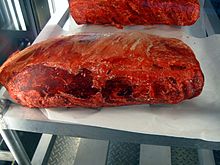- Beef aging
-
Beef aging is the process of preparing beef for consumption, mainly by breaking down the connective tissue.
Contents
Dry-aged beef
 Dry aging beef at Gallagher's Steakhouse in Las Vegas
Dry aging beef at Gallagher's Steakhouse in Las Vegas
Dry-aged beef is beef that has been hung to dry for several weeks. After the animal is slaughtered and cleaned, either an entire half will be hung, or prime cuts (large distinct sections) will be placed in a cooler, also known as a "hot box". This process involves considerable expense, as the beef must be stored near freezing temperatures. Also, only the higher grades of meat can be dry aged, as the process requires meat with a large, evenly distributed fat content. For these reasons one seldom sees dry-aged beef outside of steak restaurants and upscale butcher shops. The key effect of dry aging is the concentration and saturation of the natural flavor.
The process changes beef by two means. First, moisture is evaporated from the muscle. This creates a greater concentration of beef flavor and taste. Second, the beef’s natural enzymes break down the connective tissue in the muscle, which leads to more tender beef.
Dry aging of beef is rare in super-markets in the United States today, due to the significant loss of weight in the aging process. It is found in steakhouses and certain restaurants.
The process of dry-aging usually also promotes growth of certain fungal (mold) species on the external surface of the meat. This doesn't cause spoilage, but actually forms an external "crust" on the meat's surface, which is trimmed off when the meat is prepared for cooking. These fungal species complement the natural enzymes in the beef by helping to tenderize and increase the flavor of the meat. The genus Thamnidia, in particular, is known to produce collagenolytic enzymes which greatly contribute to the tenderness and flavor of dry-aged meat.
Wet-aged beef
Wet-aged beef is beef that has typically been aged in a vacuum-sealed bag to retain its moisture. This is the dominant mode of aging beef in the United States today. Wet-aging is popular because it takes less time (typically only a few days) and none of the weight is lost in the process. In contrast, dry-aging can take 15–28 days, and will see up to a third or more of the weight lost as moisture.
See also
- Ham, especially country ham: pork aging, Bacon
External links
Categories:
Wikimedia Foundation. 2010.
